Agile project management is by far the most popular methodology, and in a vast majority of cases, the one that offers the most value to organizations since:
- it helps to reduce product defects,
- improves the productivity of the team,
- and increases the value of the product and business.
Now, that's some good reasons to take a closer look at the concept!
What is agile project management?
Agile project management is a set of methodologies, an umbrella term for a set of frameworks and practices designed for the projects that require speed and flexibility in their process. In many cases, the projects are related to software development, but not necessarily. Agile behaviors are not beholden to any particular framework and can conceivably be implemented without one. These behaviors simply help establish a collaborative, transparent, agile environment.
It's more than project management methods such as Scrum, Kanban, Lean, Extreme Programming, or Feature-Driven Development. It's not only about roles like scrum master, project manager, product owner, or only about scrum team. Agile development is also more than practices such as sprints, stand-ups, pair programming, test-driven development, or planning sessions.
As mentioned above, agile models are based on a flexible approach. Team members work in small phases and teams to deliver a specific product or service. Each milestone or update is then tested against the customer's needs, rather than focusing on a single final product that is only released at the end of the project. Often it's necessary to test the different features of the service on the go and assess whether they are working or not to deliver the final solution. Divide up the various product updates, work on them separately, test them one by one, and you'll win.
Methodologies that are a part of the agile model (Scrum, Kanban, Lean, XP programming, etc.) are especially suitable for companies and sectors involved in contexts of constant change, especially complex projects or emergencies where we do not have the time to develop the project conventionally.
In this sense, the agile approach allows you to embrace change, without prejudice, even at the final development stage. To do this:
- It aims to deliver the highest possible business value.
- It's built based on obtaining information in real-time.
- It uses comprehensive management of costs, time, and project scope.
This set of methodologies is based on a value-driven approach that allows project managers to deliver results in high priority and high-quality conditions.
Making this approach a reality depends on knowing how to plan projects, tasks, and assign responsibilities. Agile project management reduces the complexity of each initiative by breaking it down according to:
- deadlines
- parts of the product
- test cycles
What are the origins of agile methodology?
Agile project management is a response to the limitations of traditional methods which, by the mid-1990s, were criticized due to their lack of flexibility and adaptability.
The various elements that make up the agile project management methodology have been in place for decades. However, two events helped lay the foundation for its successful approach:
The New New Product Development Game
In 1986, Harvard Business Review published in 1986 an article by Hirotaka Takeuchi and Nonaka Ikujiro entitled "The New New Product Development Game" which describes a new form of product development similar to the tactics used in a rugby match. In this project management approach, as in the field, team members can achieve their goal by continually reassessing the situation and developing a response accordingly. Therefore, projects are designed in such a way that the results obtained are fully in line with the client's expectations and needs.
The Agile Mani?esto
A group of software and project experts met to discuss what characteristics their most successful projects had in common. The values and principles on which agile project management is based were extracted from their conclusions and published under the title „The Agile Manifesto“.
The Agile Manifesto outlines 12 principles of agile. The most vital elements relate to short-term adaptability and flexibility supported by feedback culture and seamless and open communication involving all stakeholders. Flat hierarchies and motivating environment are also perceived as essential parts of any successful agile project.
Teams following any agile method should value:
- Individuals and interactions over processes and tools
- Working software over comprehensive documentation
- Customer collaboration over contract negotiation
- Responding to change over following a plan
The most common agile methodologies
If an agile team chooses to follow conventions that follow agile values and principles, this is when they start applying agile methodology. Let's have a look at some methods standard within the agile movement.
Scrum
The Scrum methodology allows tackling complex projects developed in dynamic and changing environments flexibly. It is based on partial and regular deliveries of the final product based on the value they offer to customers.
The method is ideal for managing projects within a complex environment that demands fast results and where flexibility is a prerequisite. Scrum offers an agility that always promises added value - even when it is necessary to react to a changing competitive situation at short notice, when there is a high turnover in your own team, or when you need to systematically identify and solve inefficiencies.
In the Scrum methodology, product development has a life cycle. Each phase has to correspond with the following:
- What and who? The product we want to achieve once we finish the Sprint and the team roles with their assigned tasks.
- When? The deadline and the content of the Sprint.
- How? The different tools to apply these agile processes.
If you are now wondering how this "life cycle" is structured and what exactly a "sprint" actually is: Project teams that use Scrum work in so-called sprints. This basically means nothing other than that they divide the development process into short, usually two-week sequences (sprints), that result in the delivery of a finished intermediate product. The sprint is one of five fixed Scrum events. The other four take place regularly within the respective sprints:
Sprint Planning: In the first meeting, the team determines what can be achieved within the fixed period of time that the sprint covers. At this point, requirements that need to be implemented during the project are assigned to the following sprint.
Daily Scrum: During the sprint, all team members meet daily for a stand-up meeting where they plan the next 24 hours based on progress.
Sprint Review: The Sprint Review takes place at the end of the Sprint to present the completed Increment (intermediate product). If necessary, the team updates the backlog (requirements catalog) and determines what needs to be done next.
Sprint Retrospective: The end of the Sprint is usually the Retrospective, which is held to take a closer look at the team's processes and to reveal what went well and what didn't, in order to show the participants optimization options for the further course of the Sprint.
Kanban
"Visual cards", that's what the term Kanban literally means and that's also a very accurate description of the approach. Kanban as a project management method is less complex and regulated than Scrum. The main concern: to increase efficiency through clear workflow visualization. Ultimately, the tasks to be completed should be checked off as soon as possible. To achieve this, Kanban applies three basic laws:
- workflows are visualized with the help of a Kanban board
- work in progress (tasks in process) are strictly limited
- the processing time of the tasks is to be monitored and optimized.
Three clear rules that are used to pursue Kanban's goal of keeping the focus of work on a few tasks in order to be able to perform them as efficiently as possible. As you might expect, multitasking is no longer appreciated at all. But where is the agility? Kanban does not impose strict rules, nor does it impose rigid roles and deadlines. This means that the requirements backlog can be expanded, restricted or reprioritized at any time. Short-term changes are virtually always possible, since there are no fixed sprints that have to be executed as planned.
Both Kanban and Scrum use boards, allowing the project teams to have a good overview of their own processes. This is why the two methods tend to be confused with each other, which is also why we took a closer look at the differences and peculiarities of Scrum and Kanban in another article.
Agile project management and its impact on organizations
Impact on people
This way of working emphasizes communication and collaboration among those involved in the project. Therefore, more than a definition of individual roles, it is preferred to establish the goals to be achieved as a team. The disadvantages of the approach appear when individuals are not able to develop their roles under conditions of self-management, have di?cultades to work as a team, or their stress levels increase, due to the frequency of sprints and their dynamism. Making a correct selection of personnel and monitoring their performance and levels of motivation and satisfaction are keys to the success of the implementation of the agile methodology.
Impact on progress
As soon as you apply agile methods, processes become a secondary priority. Instead of a structure based on phases, development takes place by sprints or stages that can be modified, a much more ?exible concept that allows adapting to changes more quickly. However, a little more attention is required when it comes to documentation, because this is largely based on verbal dialogs and board communication in the agile environment.
Impact on the product
The effects of agile methods on products are at their best. Instead of being limited to the original design, the highest priority is to satisfy the customer's needs at all times. There are always deliverables already in place, although with each iteration, the overall picture can continue to improve.
Only with the high degree of flexibility, that allows you to react to changes in the market at short notice, you can create the best possible product in the end.
Advantages of agile project management?
- Improved product quality: These methodologies encourage a proactive approach by team members in the quest for product excellence. In addition, the integration, testing, and continuous improvement of product properties significantly improves the final result.
- Increased customer satisfaction: The customer is more satisfied when they are involved and committed throughout the development process. Through various demonstrations and deliveries, the customer experience the improvements applied within the process in real-time.
- Increased employee motivation: Self-managed teams facilitate the development of creative and innovative environment among their members.
- Collaborative work: The division of work by different teams and roles, together with the development of frequent meetings, allows a better organization of work.
- Control and predictability: The opportunity to review and adapt the product throughout the agile process, allows all project members to control their work, which improves the ability to predict in time and costs.
- Cost reduction: Agile project management practically eliminates the possibility of absolute project failure, because errors are identified throughout the development instead of waiting for the product to be finished and all the investment made.
Disadvantages of agile project managment?
Not all companies have embraced agile methodologies with enthusiasm from the very beginning, because there ARE some things that might become more difficult to manage at some point than is the case with more traditional approaches like Waterfall.
There is a risk that documentation will fall by the wayside, making it harder for new employees to get started.
Resource planning is more challenging because it's not clear from day one what the final product will look like. While this benefits the final product, it obviously makes it difficult to accurately estimate costs and time. And the larger and more complex the project becomes, the more challenging this task grows.
Because agile reserves the right to remain flexible and always welcomes change, it also bears the risk your team going astray. There is no clear end and there is a lack of project boundaries why teams need a lot of experience to stay on track and to avoid uncontroled expansion or even scope creep at the end.
How do businesses use agile projectmanagement?
Agile project management, although created for software development, is a multi-purpose concept that can be applied to a wide variety of projects. From software engineering to HR, agile can revolutionize an organization's approach to product development, project management in general, and the implementation of internal processes.
Often, we find companies using hybrid approaches, which can be a mix of several agile approaches or even a combination of agile and traditional methods. Hybrid frameworks not only include the use of different approaches depending on the phase of the project but also include options for adopting agile practices in cascading processes.
For example, you might come accross versions that blend practices of agile with a traditional Waterfall approach. While agile project management follows a repetitive development and is flexible, the traditional follows a step-by-step development process and needs meticulous planning. Hybrid methods exploit the strengths of both to achieve a predefined project schedule, yet remain flexible within the processes - through a cycled process with multiple testing and feedback loops.
Another hybrid method would be a combination of Scrum and Kanban – Scrumban so to say – merging the best features of both, to enable a flexible development that can be adapted to changing situations and continuessly improving the processes with a strikt work-in-progress-limit.
It is worth mentioning that the choice of the features of the hybrid framework may vary according to the project.
According to the 14th Annual State of Agile Report, Scrum, and other hybrid/multiple (68%) continue to be the most common methodologies used by respondents' organizations.
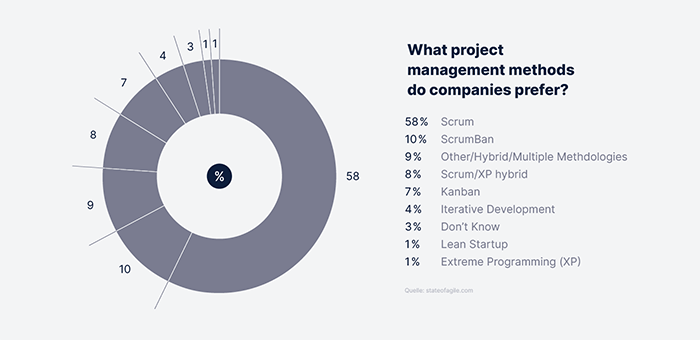
Agile methods and project management tools
There are various tools on the market that support agile methods. For Scrum Jira is one of the most common ones, though being a quite complex solution it might not be the right choice for every team, especially as teams seek an intuitive tool that can be easily used by all team members.
In addition to the high level of data security, Stackfield's greatest advantages include its high degree of flexibility and ease of use. The range of functions within the individual rooms as well as cross-organizational features can be individually combined and restricted, so that the platform is always only as extensive as the work within the respective team and organization requires it to be.
The Kanban Board can be used to store backlogs, visualize circular workflows and support agile working methods. At the same time, you can define specific approval workflows with firm rules on what status a task should have after it has been processed and by whom it should be approved. In this way, the processing of tasks can be implemented in a structured manner.
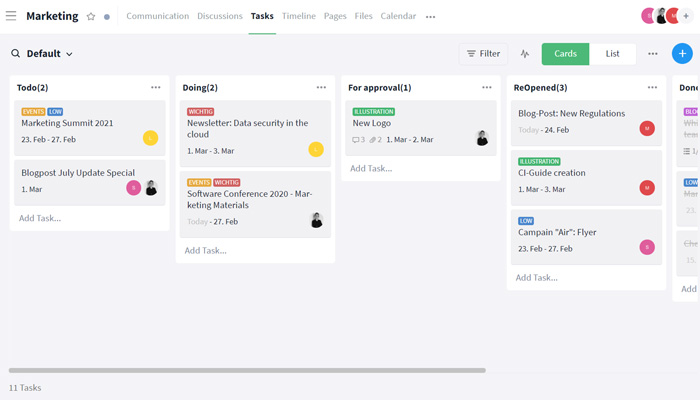
You can comment on all elements, be they tasks, pages or deadlines, and attach files to them. The communication module provides an exact chronological history of all actions and the entire exchange within the team. At the same time, the exchange on an element can always be accessed via the element itself.
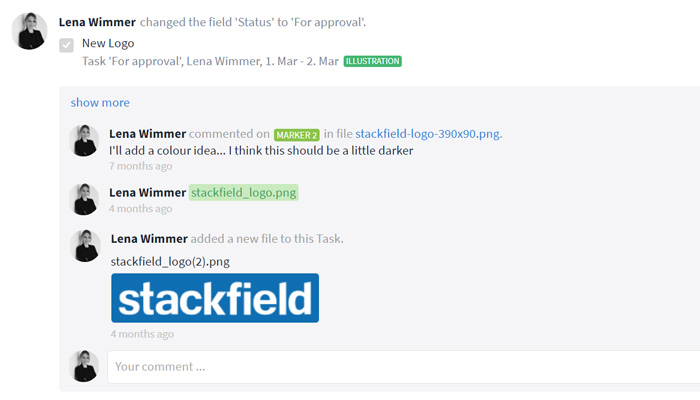
Task cards can be customized to exactly fit the way the team works using the custom fields. Use checklists, create drop-down selection lists or add additional fields for dates, texts and descriptions, numbers or another user selection. This way, all important information can be stored clearly and according to the subject matter dealt with in the room.
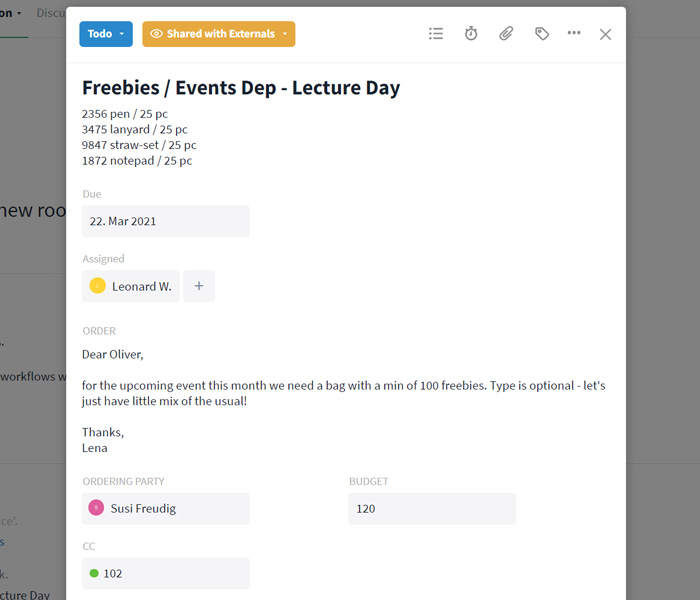
With the help of the Gantt chart, you can create a project schedule that shows a precise sequence for tasks, including all dependencies and milestones. This allows you to quickly and easily determine bottlenecks or opportunities for optimization, while maintaining an at-a-glance view of the project's overall progress.
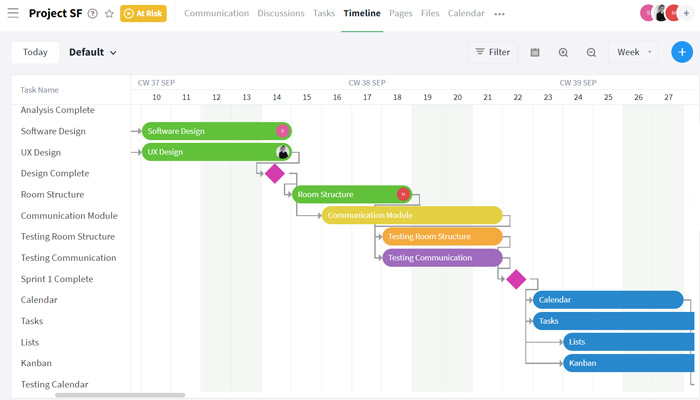
Stackfield is a comprehensive project management software with highest security measures and German company and server locations, that remains as lightweight as possible despite its wide range of functions.
Choosing the right project management methodology may not be easy. When making your decision, take into account the strengths and weaknesses of the individual methods as well as those of the project itself. A generalization is hardly possible, since one method cannot be classified as good or bad across the board. It can rather be better or worse adapted to certain requirements than another. Hybrid methods in individual configurations may be necessary to optimally meet the needs of a project. An agile approach often makes sense in project management, and those who know their project and take a closer look at its characteristics are very likely to find aspects in it where agile project management adds value.